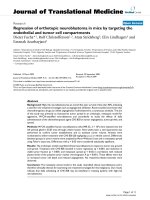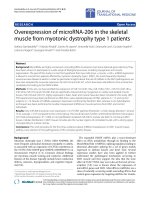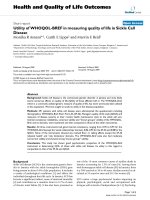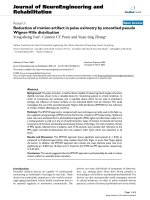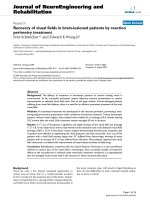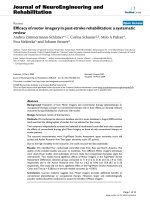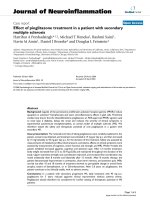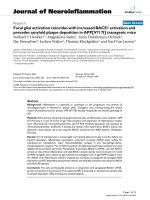báo cáo hóa học: " Production of IL-16 correlates with CD4+ Th1 inflammation and phosphorylation of axonal cytoskeleton in multiple sclerosis lesions" pptx
Bạn đang xem bản rút gọn của tài liệu. Xem và tải ngay bản đầy đủ của tài liệu tại đây (1.19 MB, 13 trang )
BioMed Central
Page 1 of 13
(page number not for citation purposes)
Journal of Neuroinflammation
Open Access
Research
Production of IL-16 correlates with CD4+ Th1 inflammation and
phosphorylation of axonal cytoskeleton in multiple sclerosis lesions
Dusanka S Skundric*
1,2
, Juan Cai
1
, William W Cruikshank
3
and
Djordje Gveric
4
Address:
1
Department of Neurology, Wayne State University School of Medicine, Detroit, MI 48201, USA,
2
Department of Immunology and
Microbiology, Wayne State University School of Medicine, Detroit, MI 48201, USA,
3
Pulmonary Center Boston University School of Medicine,
Boston, MA 02118, USA and
4
Department of Neuroinflammation, Institute of Neurology, University College London WC1N 1PJ, UK
Email: Dusanka S Skundric* - ; Juan Cai - ;
William W Cruikshank - ; Djordje Gveric -
* Corresponding author
Abstract
Background: Multiple sclerosis (MS) is a central nervous system-specific autoimmune, demyelinating and
neurodegenerative disease. Infiltration of lesions by autoaggressive, myelin-specific CD4+Th1 cells
correlates with clinical manifestations of disease. The cytokine IL-16 is a CD4+ T cell-specific
chemoattractant that is biased towards CD4+ Th1 cells. IL-16 precursor is constitutively expressed in
lymphocytes and during CD4+ T cell activation; active caspase-3 cleaves and releases C-terminal bioactive
IL-16. Previously, we used an animal model of MS to demonstrate an important role for IL-16 in regulation
of autoimmune inflammation and subsequent axonal damage. This role of IL-16 in MS is largely unexplored.
Here we examine the regulation of IL-16 in relation to CD4+ Th1 infiltration and inflammation-related
changes of axonal cytoskeleton in MS lesions.
Methods: We measured relative levels of IL-16, active caspase-3, T-bet, Stat-1 (Tyr
701
), and
phosphorylated NF(M+H), in brain and spinal cord lesions from MS autopsies, using western blot analysis.
We examined samples from 39 MS cases, which included acute, subacute and chronic lesions, as well as
adjacent, normal-appearing white and grey matter. All samples were taken from patients with relapsing
remitting clinical disease. We employed two-color immunostaining and confocal microscopy to identify
phenotypes of IL-16-containing cells in frozen tissue sections from MS lesions.
Results: We found markedly increased levels of pro- and secreted IL-16 (80 kD and 22 kD, respectively)
in MS lesions compared to controls. Levels of IL-16 peaked in acute, diminished in subacute, and were
elevated again in chronic active lesions. Compared to lesions, lower but still appreciable IL-6 levels were
measured in normal-appearing white matter adjacent to active lesions. Levels of IL-16 corresponded to
increases in active-caspase-3, T-bet and phosphorylated Stat-1. In MS lesions, we readily observed IL-16
immunoreactivity confined to infiltrating CD3+, T-bet+ and active caspase-3+ mononuclear cells.
Conclusion: We present evidence suggesting that IL-16 production occurs in MS lesions. We show
correlations between increased levels of secreted IL-16, CD4+ Th1 cell inflammation, and phosphorylation
of axonal cytoskeleton in MS lesions. Overall, the data suggest a possible role for IL-16 in regulation of
inflammation and of subsequent changes in the axonal cytoskeleton in MS.
Published: 26 May 2006
Journal of Neuroinflammation 2006, 3:13 doi:10.1186/1742-2094-3-13
Received: 07 April 2006
Accepted: 26 May 2006
This article is available from: />© 2006 Skundric et al; licensee BioMed Central Ltd.
This is an Open Access article distributed under the terms of the Creative Commons Attribution License ( />),
which permits unrestricted use, distribution, and reproduction in any medium, provided the original work is properly cited.
Journal of Neuroinflammation 2006, 3:13 />Page 2 of 13
(page number not for citation purposes)
Background
Multiple sclerosis (MS) is an inflammatory, demyelinat-
ing and neurodegenerative disease of central nervous sys-
tem (CNS) [1,2]. The complex immunopathology of MS
is initiated by infiltration of macrophages and lym-
phocytes into brain and spinal cord [3]. In patients with
MS, magnetic resonance imaging (MRI) has confirmed
that intrathecal infiltration correlates with clinically
active, acute, and relapsing stages of disease. Infiltrating
immune cells – comprised of myelin-specific and nonspe-
cific autoaggressive and regulatory T cells, B cells, NK, NK-
T and dendritic cells – are essential for myelin stripping,
degeneration of axonal cytoskeleton, and/or damage to
oligodendrocytes in MS lesions [4]. Based on a gradually
decreasing extent of inflammation over time, MS lesions
are typically classified as acute, subacute and chronic [5].
In multifaceted interactions between infiltrating cells, and
between infiltrating cells and local glial cells and/or
axons, a CD4+ Th1 cell subset has an exceptional role
because it includes potentially autoaggressive cells specific
for immunodominant epitopes of myelin proteins. Regu-
lation of Th1 immunity, which includes differentiation of
naïve CD4+ T cells into IFNγ-producing Th1 cells, is
tightly controlled by T-bet, a member of T-box transcrip-
tion factor family. In Th1-mediated autoimmune dis-
eases, T-bet is instrumental for generation of autoreactive
CD4+ Th1 cells [6-8]. Induction of T-bet depends on sig-
naling through the signal transducer and activator of tran-
scription-1 (Stat-1). Activation of Stat-1 occurs through
phosphorylation of either tyrosine-701 or serine-727
[9,10].
Homing of mononuclear cells, including encephalito-
genic CD4+ Th1 cells, into the CNS is tightly regulated by
chemoattractant factors [11]. As opposed to chemokines,
which bind to chemokine-specific receptors and do not
discriminate between distinct cell phenotypes, IL-16
binds to CD4 co-receptors and selectively chemoattracts
CD4+ T cells [12-14]. More importantly, the chemotactic
properties of this cytokine are biased towards a Th1 sub-
set, because of the close functional relationship between
CD4 molecules and CCR5 [15]. The human IL-16 precur-
sor (pro-IL-16) is a 631-amino acid, two-PDZ domain-
containing protein that is constitutively produced in
unstimulated peripheral T lymphocytes. Following CD4+
T cell activation through T cell receptors (TCR) or by
cytokines, active caspase-3 cleaves a 121-amino acid C-ter-
minal portion, which is then secreted and becomes avail-
able to bind to CD4 receptors. In addition to CD4+ T cell
migratory responses, IL-16 also regulates T cell activation,
growth, CD25 and MHC class II expression, cytokine syn-
thesis, and modulation of chemokine-induced chemoat-
traction [16,17]. Thus, IL-16 is a proinflammatory and
immunoregulatory cytokine, which has an important role
in recruitment and activation of CD4+ Th1 cells [18].
We previously reported a prominent role for IL-16 in
immune regulation of relapsing-remitting EAE in mice,
which impacted the severity of relapsing disease, of
inflammation, and of demyelination, as well as the extent
of axonal damage [19]. We provided evidence of regula-
tion of IL-16 in EAE, which suggested that production of
secreted IL-16 occurs within the CNS, and that IL-16 has a
role in specific chemoattraction of CD4+ T cells in EAE
[20]. However, the regulation of IL-16 in MS itself, and the
potential significance of IL-16 in regulating specific CD4+
Th1 inflammation and subsequent tissue damage in MS
remain largely unexplored.
In this study we investigated correlations between the reg-
ulation of IL-16, regulation of CD4+Th1 inflammation,
and inflammation-induced changes in axonal cytoskele-
ton in lesions sampled from 39 autopsies of patients with
MS and 19 controls. We found marked increases in IL-16
and active caspase-3 expression in lesions and in adjacent
normal appearing white matter (NAWM). Similarly, spe-
cific increases in T-bet and phosphorylated Stat-1 were
measured in MS lesions, providing a correlation between
CD4+ Th1 inflammation and intrathecal IL-16 produc-
tion. We observed T-bet+IL-16+ infiltrating cells in MS
lesions. Increases in phosphorylated neurofilament
medium and heavy chains [NF (M+H) P] suggested initial,
inflammation-induced changes in axonal cytoskeleton in
MS lesions and NAWM. We observed IL-16 adjacent to
abnormal-appearing axonal cytoskeletons. Overall, our
data suggest a role for IL-16 in immune regulation of
CD4+ Th1-specific inflammation, and subsequent
changes in axonal cytoskeleton, in MS.
Methods
Tissue
Postmortem snap-frozen tissue, from 39 clinically and
histopathologically definite multiple sclerosis patients
and 17 controls, was obtained from the Neuroresource
Tissue Bank at the Institute of Neurology, London, UK. All
MS cases were classified as secondary progressive (SP)
with significant increasing disability and relapsing-remit-
ting clinical course. The average age, gender, postmortem
time (PM time), Expanded Disability Status Scale score
(EDSS) [21], and duration of disease are presented in
Table 1. Cause of death in the normal control category
was unrelated to diseases of the nervous system. Multiple
sclerosis lesions were classified according to Li et al. [5].
A total of 62 frozen blocks (0.5–1 cm
3
) of brain and spi-
nal cord tissue were dissected. These included 13 acute
(AL), 13 sub-acute (SAL), and 13 chronic (CL) MS lesions,
17 adjacent areas of macroscopically normal-appearing
white (NAWM), and 6 areas of normal-appearing grey
matter (NAGM). From each tissue block, 10-µm frozen
Journal of Neuroinflammation 2006, 3:13 />Page 3 of 13
(page number not for citation purposes)
sections were cut or tissue was homogenized for protein
isolation.
Western blot
Proteins were isolated from snap-frozen tissue blocks of
approximately 1 g wet weight. Tissue was homogenized in
Tris-HCl buffer (100 mM Tris, pH 8.1 with 1% Triton X-
100) [22] by sonication. Tissue suspensions were spun at
20,000 g for 45 minutes at 4°C. Supernatants were col-
lected and stored at -70°C until use. Protein concentra-
tions were determined by the Lowry method. Equal
amounts of protein (approximately 30 µg/lane) from each
sample were loaded per lane for western blot analysis.
Protein samples were loaded with reducing conditions,
and resolved by electrophoresis in NuPage Bis-Tris (4–
12%) gels (Invitrogen, Carrsbad, CA). Electrophoresed
proteins were then transferred from the gel onto nitrocel-
lulose membrane. The membrane was blocked, and then
probed with the appropriate primary antibody overnight
at 4°C, washed three times with 0.1% Tween 20- Tris-
buffered saline, and than incubated with peroxidase-con-
jugated secondary antibody. The membrane-bound per-
oxidase activity was detected by using ECL Plus western
blotting detection kits (Amersham, Arlington Heights, IL).
Chemiluminescent images were captured and analyzed by
a Kodak Digital Science Image Station 440 CF. All blots
were studied within the linear range of exposure. In each
sample, levels of IL-16, active caspase-3, T-bet, Stat-1
(Tyr
701
), and NF (M+H)-P, were normalized to corre-
sponding levels of GAPDH.
Immunostaining and confocal microscopy
Frozen sections, 10 µM thick, were used to analyze pheno-
types of infiltrating cells by immunofluorescence follow-
ing a routine procedure [19]. Briefly, sections were air-
dried, acetone-fixed, and treated with 10% normal don-
key serum for 10 minutes, followed by overnight incuba-
tion with relevant primary antibody (Table 2) in a moist
chamber at +4°C. The slides were then washed and incu-
bated with secondary fluorochrome-labeled antibodies
for 30 minutes. The following secondary antibodies were
used: anti-goat, anti-rabbit and anti-mouse IgG-HRP con-
jugated at 1:10,000, (Santa Cruz Biotechology, CA).
Nuclear staining was performed using 30 nM 4',6-diamid-
ino-2-phenylindole, dihydrochlpride (DAPI) (Molecular
Probes). The slides were washed, mounted in Gelmount
(Biomeda, Foster City, CA), and analyzed by light and flu-
orescent microscopy. Images were captured on a Nikon
Eclipse 600 epifluorescent microscope with a Princeton
Instruments Micromax 5 MHz cooled CCD camera.
Statistical analysis
All statistical analyses were done using GraphPad Prism
software (GraphPad, San Diego, CA). The significance of
differences between groups was calculated using Student's
t-test. The level of statistical significance was set at p <
0.05.
Results
Levels of pro- and secreted IL-16 are distinctly regulated in
acute, subacute and chronic MS lesions in brain and spinal
cord
MS lesions showed marked increases in levels of IL-16
precursor (pro-IL-16, 80 kD), and mature, secreted IL-16
(22 kD), compared to normal control brain and spinal
cord white matter (Fig. 1). Pro-IL-16 was undetectable in
control brain (Fig. 1A), and was very low in control spinal
cord white matter (Fig. 1B), but was abundantly present in
MS lesions in brain and spinal cord. In brain, levels of pro-
IL-16 did not differ significantly between acute and
chronic lesions. Interestingly, in normal-appearing white
matter (NAWM) adjacent to acute lesions, pro-IL-16 levels
were approximately one third those of acute lesions, while
in normal-appearing grey matter (NAGM) pro-IL-16 lev-
els were elevated more than two fold over levels in acute
lesions (Fig. 1A). In MS lesions in spinal cord, levels of
pro-IL-16 was greatest in acute lesions, reaching approxi-
mately five times control levels. Subacute and chronic
lesions showed significantly lower levels of pro-IL-16 than
did acute lesions, and these were indistinguishable from
control levels. As was found for brain, spinal cord NAWM
showed appreciable levels of pro-IL-16. These levels were
lower than those measured in acute lesions, but still mark-
edly higher than control levels (Fig. 1B).
Mature IL-16 showed patterns similar to those of pro-IL-
16. Mature IL-16 was also undetectable in control brain
white matter by western blot. An abundant presence of
secreted IL-16 was measured in acute, subacute and espe-
cially in chronic MS lesions in brain. Differences between
these types of lesions were not significant. NAWM and
NAGM showed secreted levels of IL-16 that were approxi-
mately one half to one fifth those of acute MS lesions, but
still appreciable by western blot, especially in NAWM (Fig.
1A). In normal spinal cord, secreted IL-16 was detected at
very low levels. In acute spinal cord lesions, the content of
secreted IL-16 was over ten times higher than basal levels.
Table 1: Summary of clinical data
Control Multiple sclerosis
Number of cases 17 39
Age (years – mean ± SD, range) 59 ± 15 (34–78) 54 ± 13 (31 – 66)
Gender (F/M) 4/13 27/12
PM time 24 ± 9 21 ± 6
Duration of MS (years) NA 22 ± 11
EDSS NA 9
Clinical classification NA SP
NA = non applicable; F = female, M = male; PM = post mortem; EDSS
= Expanded Disability Status Scale score; SP = secondary progressive
Journal of Neuroinflammation 2006, 3:13 />Page 4 of 13
(page number not for citation purposes)
Significant downregulation of secreted IL-16 was
observed in subacute and chronic lesions and in NAWM,
in comparison to acute lesions (Fig. 1B). The relative lev-
els of IL-16 in spinal cord appear to be consistently higher
than those of brain.
Regulation of active caspase-3 parallels secreted IL-16 and
suggests a role for this caspase in enzymatic cleavage of
pro-IL-16 in MS lesions
We used an anti-caspase-3 antibody that reacts with both
pro-caspase-3 (32 kD) and its cleavage fragment, which
represents active caspase-3 (20 kD), for western blot anal-
ysis. In white and grey matter of control brains levels of
pro-caspase-3 were appreciable, while active caspase-3
was not detected. In MS lesions from MS brains, levels of
pro-caspase-3 were not significantly higher than basal lev-
els but an increase in active caspase-3 was observed. (Fig.
2A). In spinal cord, control levels of pro-caspase-3 were
very low but still detectable, while active caspase-3 was
virtually undetectable. Compared to low basal levels in
normal spinal cord, pro- and active caspase-3 were mark-
edly increased in spinal cord MS lesions (Fig. 2B). Active
caspase-3 showed high levels in chronic MS lesion of
brain and spinal cord; a pattern similar to that seen for IL-
16 (Fig. 1).
The antibody specific for IL-16 that we used for both
immunostaining and western blot binds to the C-terminal
portion of both pro- and secreted IL-16 and therefore does
not allow distinction between two forms of IL-16 based
on immunostaining. To examine whether cleavage of pro-
IL-16 may occur in infiltrating IL-16+ cells, we performed
double immunostaining using an antibody that recog-
nizes the p17 subunit of active caspase-3 (Table 2) and the
IL-16-specific antibody. Isotype-matched control anti-
body (Table 2) was used to confirm the specificity of IL-16
immunostaining (not shown). We observed numerous IL-
16+ active-caspase-3+ mononuclear cells, suggesting that
production of secreted IL-16 occurs within MS lesions
(Fig. 4B). While active caspase-3 was confined to nuclei,
IL-16 immunoreactivity was rarely observed in nuclei.
This was more often found polarized on cell membranes
or adjacent to mononuclear cells (Fig. 4A and 4B, and Fig.
6B). In perivenular and white matter-scattered infiltrates
within MS tissus, IL-16 immunoreactivity was often found
at the sites of cell-cell contact between mononuclear cells
(Fig. 4A, B). In NAWM, IL-16 was observed in sparse infil-
trating lymphocytes and in their vicinity.
Within MS lesions, elevated levels of secreted IL-16
correspond to increased CD4+ Th1 infiltration and
signaling, as measured by T-bet expression, and Stat-1
phosphorylation
T-bet was not detected in control brain and spinal cord,
but T-bet levels were appreciable in MS lesions (Fig. 3).
Levels of T-bet were markedly increased in acute and
chronic MS lesions in brain, (Fig. 3A) and in acute spinal
cord lesions (Fig. 3B), corresponding to increases in IL-16.
Levels of T-bet in spinal cord were greatest in acute
lesions, and gradually decreased in subacute and chronic
lesions. This pattern of T-bet regulation was expected
based on routine histopathology of these lesions, where
inflammatory infiltration also decreased from acute to
subacute and chronic lesions [5]. In brain lesions, levels of
T-bet were almost equally high in acute and chronic
lesions, and corresponded to similarly high levels of
secreted IL-16 (Fig. 1A). Conversely, in spinal cord, T-bet
and secreted IL-16 levels were decreased in subacute and
chronic as compared to acute lesions (Fig. 1B and Fig. 3B).
Intrathecal levels of Stat-1 (Tyr
701
) were undetectable in
controls, but were found at appreciable levels in acute MS
Table 2: Primary antibodies used for immunostaining and western blot
Antigen Clone Dilution Form Source Immuno/WB
IL-16 14.1 1:1000 BD Biosciences San Diego CA WB
IL-16 14.1 1:200 PE BD Biosciences San Diego CA IC
G155-178 (control) 1:200 PE BD Biosciences San Diego CA IC
Caspase-3 Polycloal 1:1000 R&D Systems Minneapolis MN WB
Active- Caspase-3 Polycloal 1:200 R&D Systems Minneapolis MN IC
T-bet Poly6235 1:500 Biolegend San Diego CA WB
Stat-1 Polycloal 1:1000 Cell Signaling Technology Co Danvers MA WB
Stat-6 Polycloal 1:1000 Cell Signaling Technology Co Danvers MA WB
NF(H+M) NP1 1:500 Chemicon Temecula CA WB
GAPDH Polycloal 1:1000 Santa Cruz Biotechnology Santa Cruz CA WB
CD3 APA1/1 1:100 FITC BD Biosciences San Diego CA IC
CD4 RPA-T4 1:100 FITC BD Biosciences San Diego CA IC
CD8 3b5 1:100 FITC Caltag Laboratories Bulingame CA IC
CD11b/Mac-1 ICRF44 1:50 Biotin BD Biosciences San Diego CA IC
CD20 H147 1:500 FITC Caltag Laboratories Bulingame CA IC
CD83 HB15e 1:500 FITC Caltag Laboratories Bulingame CA IC
Journal of Neuroinflammation 2006, 3:13 />Page 5 of 13
(page number not for citation purposes)
lesions, and at lower levels in subacute and chronic MS
lesions in brain and spinal cord (Fig. 3C). Regulation of
Stat-1 (Tyr
701
) correlated well with trends measured for T-
bet and secreted IL-16 in MS lesions. In contrast to
increased phosphorylation of Stat-1, we did not detect
phosphorylated Stat-6 (Tyr
641
) (not shown), suggesting
that Stat-1-specific signaling is preferential over Stat-6-
specific activation in MS lesions.
Extensive IL-16 immunostaining, confined to infiltrating
cells, was observed in MS lesions. Less widespread immu-
nostaining was found in normal-appearing white matter
of brain and spinal cord. IL-16 immunoreactivity was
readily observed in CD3+ T cells in perivenular infiltrates
(Fig. 6A). Within the pool of infiltrating mononuclear
cells, a subset of T-bet+ cells frequently expressed IL-16
(Fig. 4A). IL-16 nuclear immunostaining was seldom
observed, while IL-16 often appeared as cytoplasmic or
membrane-bound immunostaining, or adjacent to cells
as secreted product. IL-16 was found frequently between
adjoining mononuclear cells (Fig. 4A and 4B).
MS lesions contain increased levels of pro- and secreted IL-16 compared to control tissueFigure 1
MS lesions contain increased levels of pro- and secreted IL-16 compared to control tissue. Markedly different rel-
ative levels of IL-16 were measured between different types of lesions and control (A) brain and (B) spinal cord tissue, by
western blot. Representative blots show levels of pro-IL-16 (80 kD) and secreted IL-16 (22 kD) in: (A) normal control (periv-
entricular white matter of left parietal lobe), and MS brains. Periventricular white matter of MS lesions and adjacent normal-
appearing white matter were sampled from: AL (acute lesion – right parietal lobe); NAWM (normal appearing white matter –
right temporal lobe); NAGM (normal-appearing grey matter – right temporal lobe); SAL (subacute lesion – right parietal lobe)
and CL (chronic lesion – right parietal lobe); and (B) spinal cord: lumbar spinal cord was analyzed from control and MS
patients. Representative blots are shown from a total of 7 experiments analyzing 39 MS cases and 19 controls. Relative levels of
IL-16/GAPDH were estimated by densitometry. Mean values ± SD are shown in corresponding graphs.
22 kD
80 kD
A) Brain
B) Spinal cord
80 kD
22 kD
GAPDH
GAPDH
Levels of pro- and secreted IL-16 in CNS
0.00
0.40
0.80
1.20
1.60
C
o
ntrol
AL
SAL
C
L
NAWM
NAG
M
IL -16/G APD
H
pro-IL-16
secreted -IL-16
0.00
1.00
2.00
3.00
C
o
n
t
r
o
l
A
L
S
A
L
C
L
N
A
W
M
IL-16/G APD
H
pro-IL-16
secreted-IL-16
Control AL SAL CL NAWM
Control AL SAL CL NAWM NAGM
*
**
*p< 0.005
**p<0.001
**
**
*
**
**
**
**p< 0.001
**
**
**
**
**
**
Journal of Neuroinflammation 2006, 3:13 />Page 6 of 13
(page number not for citation purposes)
In addition to co-localization with CD3+ and CD4+ T
cells, some IL-16 immunoreactivity was confined to CD8+
T cells, CD20+ B cells, and CD83+ dendritic cells (not
shown). Occasional Mac-1+ microglia were IL-16+, while
the majority of cells expressing Mac-1 did not contain IL-
16 (not shown).
Intrathecal production of IL-16 correlates with increased
levels and fragmentation of phosphorylated neurofilament
medium and heavy chains [NF(M+H)]P
Phosphorylated neurofilament medium (160 kD) and
heavy (220 kD) chains [NF(M+H)]P, were detected in
control brain and spinal cord tissue at appreciable levels.
In MS lesions, levels of these neurofilaments were highly
upregulated compared to control tissue. Upregulation of
[NF(M+H)]P was readily accompanied by its degradation
in MS lesions. The most prominent change in levels and
Levels of active -caspase-3 are elevated in MS lesionsFigure 2
Levels of active -caspase-3 are elevated in MS lesions. Levels of pro-caspase-3 (32 kD) and active capsase-3 (20 kD)
were measured in (A) brain and (B) spinal cord. A) While pro-caspase was found at relatively high levels, active-caspase-3 was
not detected in normal control white matter (NCWM) and normal control grey matter (NCGM) in brain. A decrease of pro-
caspase-3 was followed by an increase of active caspase-3 in MS lesions. B) As opposed to brain, very low basal levels of pro-
and active caspse-3 were found in control spinal cord. Dramatic increases of pro-caspase-3 was measured in acute lesions (AL),
which then subsided in subacute lesions (SAL) and chronic lesions (CL). Levels of active caspase-3 were markedly and persist-
ently higher in MS lesions compared to control tissue. Representative blots are shown from a total of 5 experiments analyzing
39 MS cases and 19 controls. Relative levels of Caspase-3/GAPDH are estimated by densitometry. Mean values ± SD are
shown in corresponding graphs.
A) Brain
B) Spinal cord
32kD
20kD
32kD
20kD
GAPDH
GAPDH
Levels of Caspase-3 in CNS
NCWM NCGM AL SAL CL NAWM
Control AL SAL CL
0.00
0.50
1.00
1.50
2.00
2.50
NCWM
N
CGM
AL
SA
L
CL
NA
W
M
CASPASE-3/GAPD
H
pro-caspase-3
active-caspase-3
*p<0.005
**p<0.001
*
**
**
** **
**
**
* P<0.002
0.00
1.00
2.00
3.00
4.00
C
ontrol
A
L
S
AL
C
L
CASPASE-3/GAPD
H
pro-caspase-3
active-caspase-3
** p<0.001
**
**
**
**
**
**
**
Journal of Neuroinflammation 2006, 3:13 />Page 7 of 13
(page number not for citation purposes)
degradation of [NF(M+H)]P was observed in acute lesions
in brain and spinal cord (Fig. 5A and 5B). In subacute and
chronic lesions, degradation of [NF(M+H)]P persisted;
levels were approximately one half those of acute lesions
but still markedly higher than those of controls. The
observed patterns of regulation of [NF(M+H)]P corre-
spond to those of IL-16 (Fig. 1) in MS lesions.
Abnormalities in appearance of phosphorylated neurofil-
aments (medium and heavy) chains [NF(M+H)]P, were
observed in MS lesions and, interestingly, also in NAWM.
Small, rounded, irregularly shaped fragments of neurofil-
aments were readily observed (Fig. 6B). IL-16 immunos-
taining was found either confined to mononuclear cells or
in the proximity of cells adjacent to irregular appearing
neurofilaments (Fig. 6B).
Discussion
Our observations suggest an important role for the
cytokine IL-16 in regulation of CD4+ T cell infiltration, of
severity and frequency of relapses, and of subsequent
demyelination and axonal damage, in a mouse model of
EAE [19]. These observations suggest that IL-16, which
serves as a specific ligand for the CD4 co-receptor, may
have a similar role or roles in regulation of MS. In other
organs, increased levels and processing of IL-16 is associ-
Elevated levels of T-bet and phosphorylated Stat-1 suggest substantial infiltration by CD4+ Th1 cell in MS lesionsFigure 3
Elevated levels of T-bet and phosphorylated Stat-1 suggest substantial infiltration by CD4+ Th1 cell in MS
lesions. Expression of T-bet was not detected in control brain (A) or spinal cord (B). In MS lesions, relatively high levels T-bet
were measured in acute lesions (AL) and chronic lesions (CL) in brain, and in AL in spinal cord. Compared to AL, markedly
lower levels of T-bet were found in subacute lesions (SAL) and NWAM. C) Regulation of Stat-1 was similar to that of T-bet in
brain. Phospho-Stat-1 (Tyr
701
) was not detected in control brain. Conversely, it was abundant in AL and CL in brain. Repre-
sentative blots are shown from a total of 5 experiments analyzing 39 MS cases and 19 controls. Relative levels of T-bet/GAPDH
and Stat-1 (Tyr
701
)/GAPDH were estimated by densitometry. Mean values ± SD are shown in corresponding graphs.
58 kD
A) Brain
Control AL SAL CL
B) Spinal cord
T-bet
GAPDH
Stat-1(Tyr701)
Control AL SAL CL NAWM
84 kD
GAPDH
0.00
0.20
0.40
0.60
0.80
Control
AL
SA
L
CL
T-BE T/G AP
D
Start-1(Thy701)
0.00
0.10
0.20
0.30
Control
A
L
SA
L
CL
NAW
M
PSTART-1/GAP
DH
0.00
0.40
0.80
1.20
Control
A
L
SA
L
CL
NA
W
M
T-BET/GAPD
H
Control AL SAL CL NAWM
*p < 0.005
**p < 0.001
** **
*
**p < 0.001
**
**
**p < 0.001
**
C) Brain
Journal of Neuroinflammation 2006, 3:13 />Page 8 of 13
(page number not for citation purposes)
IL-16 immunoreactivity is observed confined to T-bet+ cells and active caspase-3+ cells in MS lesionsFigure 4
IL-16 immunoreactivity is observed confined to T-bet+ cells and active caspase-3+ cells in MS lesions. A) In
acute lesions (AL) in MS brain, prominent T-bet+ cells were found in small infiltrates scattered throughout the white matter of
parietal lobe. IL-16 immunoreactivity was observed at similar locations within the lesion. DAPI staining indicates that the immu-
nostaining is localized to mononuclear cells. The merged image shows that IL-16 immunoreactivity co-localizes to some T-bet+
cells. The image on the far right shows enlarged detail from the merged image (at arrows), where IL-16 confined to T-bet+
cells (at arrows) can be better appreciated. It also shows a T-bet+ cell, which is IL-16- (arrowhead), and a T-bet-, IL-16- cell
(asterisk). B) In an AL of lumbar spinal cord, intense immunostaining for IL-16 and for active caspase-3 is seen in dense perive-
nular mononuclear cell infiltrates in the white matter. A detail from the merged image (at arrows) is shown in the far right
image. Most infiltrating cells exhibit a nuclear pattern of immunostaining for active caspase-3. Some of these active caspse-3+
cells are IL-16+ (at arrows). Note the distinct patterns of IL-16 and active caspase-3 immunostaining. While IL-16 nuclear
immunostaining is observed occasionally (asterisk), more often it appears as cytoplasmic or membrane-bound immunostaining,
or as secreted product adjacent to cells (at arrows). IL-16 was found frequently between adjoining mononuclear cells (arrow-
head). Two color fluorescence × 60.
Journal of Neuroinflammation 2006, 3:13 />Page 9 of 13
(page number not for citation purposes)
ated with the pathogenesis of delayed type hypersensitiv-
ity [23] and autoimmunity, such as in atopic dermatitis
[24], with autoimmune rheumatoid arthritis and lupus
[25,26]. However, the role of IL-16 regulation in MS
lesions is largely unknown. With the exception of one
report, which shows IL-16 immunoreactivity within
lesions of a single case of MS, this has been little studied
and the mechanisms of IL-16 regulation in MS remain
elusive [27]. In this previous study, it was not apparent if
IL-16 expression in MS differed from that of control adult
CNS, or if the IL-16 expression was due to precursor or
secreted IL-16. The cellular localization of IL-16 immuno-
reactivity suggested expression in microglia-like cells,
although it did not correspond with the expression of sev-
eral microglia activation markers. Some of the IL-16
immunoreactivity was found to be related to lymphocytes
and astrocyte-like cells.
To asses the potential role of locally produced IL-16 in
regulation of neuroinflammation and axonal damage, key
markers of MS pathology, we specifically addressed the
following questions: Does production of mature IL-16
occur within MS lesions? What are the phenotypes of IL-
16-containing or -producing cells? Does intrathecal IL-16
accumulation correlate with specific CD4+ Th1 inflam-
mation and damage of axonal cytoskeletons?
Alterations of axonal cytoskeleton are suggested by markedly increased levels of phosphorylated medium and heavy chains of neurofilament [NF (M+H)P] in MS lesionsFigure 5
Alterations of axonal cytoskeleton are suggested by markedly increased levels of phosphorylated medium and
heavy chains of neurofilament [NF (M+H)P] in MS lesions. Relative levels of NF (M+H)P are markedly increased in MS
lesions in (A) brain and spinal (B) cord compared to control values. Control tissue displays two distinct bands corresponding
to 160-kD medium and 200-kD heavy neurofilament chains. In contrast, MS lesions show bands that cannot be clearly distin-
guished due to hyperphosphorylation. Representative blots are shown from a total of 5 experiments analyzing 39 MS cases and
19 controls. Relative levels of NF(M+H)P/GAPDH are estimated by densitometry. Mean values ± SD are shown in correspond-
ing graphs.
A) Brain
B) SPINAL CORD
200 kD
GAPDH
GAPDH
Control AL SAL CL
Phosphorylated NF(H+M)
Control AL SAL CL
0.00
2.00
4.00
6.00
C
on
t
rol
AL
S
A
L
CL
NF(H+M)P?GAPD
H
SPINAL CORD
0.00
2.00
4.00
6.00
Control
A
L
SAL
C
L
NF(H+M)P/GAPDH
160 kD
200 kD
160 kD
*p < 0.001
**
**
**
*p < 0.001
**
**
**
Journal of Neuroinflammation 2006, 3:13 />Page 10 of 13
(page number not for citation purposes)
IL-16 immunoreactivity is present in occasional infiltrating lymphocytes adjacent to degenerate axonal cytoskeletons, in nor-mal-appearing white matter (NAWM)Figure 6
IL-16 immunoreactivity is present in occasional infiltrating lymphocytes adjacent to degenerate axonal
cytoskeletons, in normal-appearing white matter (NAWM). A) Occasional IL-16-positive CD3+ T cells were
observed around small venules in NAWM adjacent to acute lesions in spinal cord (at arrows). B) Note degenerate axonal neu-
rofilaments [NF(M+H)P], which appear rounded, ballooned and irregularly shaped (at arrows). Some IL-16 immunoreactivity
was observed in the proximity of axons, either confined to or adjacent to sparse infiltrating mononuclear cells (merged image,
arrows). Note that IL-16 does not co-localize with axonal neurofilament. Two color fluorescence × 40.
Journal of Neuroinflammation 2006, 3:13 />Page 11 of 13
(page number not for citation purposes)
Here we present our findings on the expression and dis-
tinct regulation of pro- and secreted IL-16 in acute, suba-
cute and chronic MS lesions, and in normal-appearing
white matter, from brain and spinal cord of 39 patients
with MS and 19 normal controls.
As anticipated, the highest levels of pro- and secreted IL-
16 were found in acute lesions. The marked increases in
secreted IL-16 over control levels in brain and spinal cord
suggests a role for IL-16 in regulation of neuroinflamma-
tion in acute lesions. Locally produced IL-16 may further
support production of inflammatory cytokines by infil-
trating mononuclear cells, in a fashion similar to that seen
in vitro [17]. In this way, IL-16 may support inflammation
in a complex network of pro- and anti- inflammatory
pathways occurring in acute lesions [28,29]. Surprisingly
high levels of secreted IL-16 in chronic lesions, and lower
but still above normal levels in normal appearing white
matter, may be due to generalization of inflammatory and
degenerative processes beyond focal demyelinating
plaques and beyond macroscopically defined lesions.
Such pathology is consistent with diffuse inflammation
and with accumulating axonal injury during the progres-
sive course of MS, as suggested by others [30]. Alterna-
tively, IL-16 found in chronic lesions and in normal white
and grey matter adjacent to lesions may originate from
neuronal IL-16 (NIL-16). Lymphoid IL-16 is transcribed
from an intronic promoter lying within the NIL-16 gene.
C-terminal regions of IL-16 and NIL-16 share 100% simi-
larity. NIL-16 is produced by neurons primarily in cerebel-
lum and in hippocampus. In vitro, at least, neuronal
apoptosis leads to cleavage of NIL-16 by active caspase-3
and secretion of C-terminal bioactive IL-16 [31]. Whether
similar mechanisms operate in vivo during neuronal dam-
age is not known. The lack of NIL-16 in normal control
samples may reflect the anatomic distribution of NIL-16
expression. Alternatively, epitope for mAb 14.1 may be
masked in NIL-16. Even if this antibody does detect intact
NIL-16, following cleavage with active caspase-3, it would
not detect the N-terminal domain of NIL-16. Our finding
of IL-16 in MS tissue devoid of macroscopically significant
mononuclear infiltration and/or microglial activation
argues for a role for IL-16 in progression and spreading of
focal inflammatory lesions. Our data showing substan-
tially increased secreted IL-16 in CNS of mice with chronic
EAE [20] support this proposed role for IL-16.
Slight differences were observed between brain and spinal
cord in regulation of IL-16, active caspase-3, T-bet, Stat-2
(Tyr
701
) and NF(M+H)P, which may suggest the existence
of distinct regulatory mechanisms of neuroinflammation
in these two regions. The absence of appreciable IL-16
expression in control brain and spinal cord argues against
an important physiological role for IL-16 in the mainte-
nance of homeostasis within normal CNS.
In MS lesions, putative producers of IL-16 include CD4+,
CD8+ T cells, B cells, dendritic cells, and subsets of acti-
vated microglia. Locally produced bioactive IL-16 may
exert its paracrine effects by binding to CD4 co-receptor. A
minimal peptide RRKS, between Arg
106
and Ser
109
of C-
terminally cleaved bioactive IL-16, is essential for the
binding and signaling through CD4 [32]. This specific
localization of intrathecal IL-16 bears relevance to its sev-
eral potentially important roles: in local immunomodula-
tion through regulation of CD4+T-T cell communication;
in CD4+T cell helper function in the processes of T-B cell
communication; and lastly in local antigen presentation
by dendritic cells and microglia. A role for IL-16 in the
cross talk between dendritic cells and T cells has also been
proposed [33].
The Stat-1 protein plays a central role in the biological
activity of both type I and type II interferons. Th1-derived
IFNγ binds to its specific receptor on the surface of T cells
and initiates signaling cascade, which includes Stat-1
phosphorylation and nuclear translocation. T-bet is regu-
lated by IFNγ-, Stat-1-mediated signaling, and its level is
markedly reduced in IFNγ- or Stat-1-mutant cells [34].
Inflammation-induced changes in axonal cytoskeletons,
which include increased levels of phosphorylated
medium and heavy chains of neurofilament, readily lead
to axonal dysfunction [1,35]. Our finding of IL-16 immu-
noreactivity in the vicinity of degenerate neurofilaments,
which appears to be secreted from mononuclear cells (Fig.
6), suggests that this proinflammatory cytokine may par-
ticipate in damage to axonal cytoskeletons.
Conclusion
We find extensive production of IL-16 in MS lesions and
in adjacent normal-appearing white (NAWM) and grey
matter (NAGM) in both brain and spinal cord of MS
patients. Increased levels of secreted IL-16 correlated with
elevated levels of active caspase-3, T-bet and Stat-1
(Tyr
701
). Within both MS lesions and NAWM, active-cas-
pase-3+ IL-16+, and T-bet+IL-16+ mononuclear cells were
readily observed. A specific localization of IL-16 to sites of
cell-cell contact was frequently observed, suggesting a role
in cell-to-cell communication. We found similarities in
patterns of regulation between secreted IL-16 and active
caspase-3 that suggest production of secreted IL-16 within
lesions by active caspase-3-dependent cleavage of pro-IL-
16. Conversely, similarities in patterns of regulation
between IL-16, T-bet and Stat-1 (Tyr
701
) suggest contribu-
tions of CD4+Th1 cell subsets to IL-16 local production,
and/or a role for locally produced secreted IL-16 in
CD4+Th1 cell homing.
Increased production of secreted IL-16 corresponded with
marked elevations in phosphorylated neurofilament
Journal of Neuroinflammation 2006, 3:13 />Page 12 of 13
(page number not for citation purposes)
medium and heavy chains, suggesting inflammation-
induced changes in axonal cytoskeleton in MS lesions and
NAWM. IL-16+ mononuclear cells were observed adjacent
to these axons; these were frequent in MS lesions and
sparse in NAWM.
Taken together, our data suggest an important role for
intrathecally secreted IL-16 in specific regulation of
CD4+Th1 cell homing, Th1-mediated neuroinflamma-
tion, and subsequent changes in axonal cytoskeleton in
MS. Our results also suggest a role for IL-16 in processes
of cell-to-cell communication in MS lesions.
Abbreviations
IL-16: interleukin 16
EAE: experimental autoimmune encephalomyelitis
MS: multiple sclerosis
AL: acute lesion
SAL: subacute lesion
CL: chronic lesion
NAWM: normal appearing white matter
NAGM: normal appearing grey matter
NCWM: normal control white matter
NCGM: normal control grey matter
NF(M+H)P: phosphorylated medium and heavy chains of
neurofilament
Stat-1: signal transducer and activator of transcription-1
Competing interests
The author(s) declare that they have no competing inter-
ests.
Authors' contributions
DSS conceived the design of the study, provided critical
analysis of the data, and wrote the manuscript. She per-
formed immunocytochemistry and confocal analysis of
MS tissue sections. JC performed the western blot analysis
and helped with immunostaining and statistical analysis.
WWC provided critical analysis of the manuscript. JG
selected and provided MS samples and performed routine
histopathology analysis of MS lesions. He contributed to
critical review of the manuscript. All authors read and
approved the final version of the manuscript.
Acknowledgements
We thank the Chairman, Dr Robert P. Lisak for the support from Parker
Webber Funds, and Dr Joyce Benjamins for critical reading of the manu-
script. D.G. was supported by Multiple Sclerosis Society of Great Britain.
We thank Ms Jessica De Jullian for technical assistance in manuscript prep-
aration.
References
1. Bjartmar C, Trapp BD: Axonal degeneration and progressive
neurology disability in multiple sclerosis. Neurotox Res 2003,
5:157-64.
2. Lassmann H, Bruck W, Lucchinetti C: Heterogeneity of multiple
sclerosis pathogenesis: implications for diagnosis and ther-
apy. Trends Mol Med 2001, 7:11-21.
3. Hickey WF, Hsu BL, Kimura H: T-lymphocyte entry into the cen-
tral nervous system. J Neurosci Res 1991, 28:254-60.
4. Steinman L: Immune therapy for autoimmune diseases. Science
2004, 305:212-216.
5. Li H, Newcombe J, Croome NP, Cuzner MI: Characterization and
distribution of phagocytic macrophages in multiple sclerosis
plaques. Neuropath Appl Neurobiol 1993, 19:214-23.
6. Szabo SJ, Kim ST, Costa GL, Zhang X, Fathman CG, Glimcher LH: A
Novel Transcription Factor, T-bet, Directs TH1 Lineage
Commitment. Cell 2000, 100:655-69.
7. Lovett-Racke AE, Rocchini AE, Choy J, Northrop SC, Hussain RZ,
Ratts RB, Sikder D, Racke NK: Silencing T-bet defines a critical
role in the differentiation of autoreactive T lymphocytes.
Immunity 2004, 21:719-31.
8. Robinson DS, O'Garra A: Further checkpoints in Th1 develop-
ment. Immunity 2002, 16:755-58.
9. Imada K, Leonard WJ: The Jak-STAT pathway. Mol Immunol 2000,
37:1-11.
10. Lee YJ, Benveniste EN: Start1 alpha expression is involved in
IFN-gamma induction of the class II transactivator and class
II MHC genes. J Immunol 1996, 157:1559-68.
11. Trebst C, Ransohoff RM: Investigating chemokines and chem-
okine receptors in patients with multiple sclerosis. Arch Neu-
rol 2001, 58:1975-80.
12. Cruikshank W, Center DM: Modulation of lymphocyte migra-
tion by human lymphokines. II. Purification of lymphotactic
factor (LCF). J Immunol 1982, 128:2569-71.
13. Cruikshank W, Kornfeld H, Center DM: Interleukin-16. J Leukocyte
Biol 2000, 67:757-66.
14. Wilson KC, Center DM, Cruikshank WW: The Effect of Inter-
leukin-16 and its Precursor on T Lymphocyte Activation and
Growth. Growth Factors 2004, 22:97-104.
15. Lynch EA, Heijens CA, Horst NF, Center DM, Cruikshank WW:
Cutting edge: IL 16/CD4 preferentially induces Th1 cell
migration: requirement of CCR5. J Immunol 2003, 171:4965-68.
16. Cruikshank WW, Center DM, Nisar N, Wu M, Natke B, Theodore
AC, Kornfeld H: Molecular and functional analysis of a lym-
phocyte chemoattractant factor: Association of biologic
function with CD4 expression. Proc Natl Acad Sci USA 1994,
91:5109-13.
17. Mathy NL, Scheuer W, Lanzendorfer M, Honold K, Ambrosius D,
Norley S, Kurth R: Interleukin-16 stimulates the expression
and production of pro-inflammatory cytokines by human
monocytes. Immunol 2000, 100:63-69.
18. Center DM, Kornfeld H, Cruikshank WW: Interleukin 16 and its
function as a CD4 ligand. Immunol 1996, 17:476-81.
19. Skundric DS, Dai R, Zakarian VL, Bessert D, Skoff RP, Cruikshank
WW, Kurjakovic Z: Anti-IL-16 Therapy Reduces CD4+ T-Cell
Infiltration and Improves Paralysis and Histopathology of
Relapsing EAE. J Neurosci Res 2005, 79:680-93.
20. Skundric DS, Zhou W, Cruikshank WW, Dai R: Increased level of
bioactive IL-16 correlate with disease activity during relaps-
ing experimental autoimmune encephalomyelitis (EAE). J
Autoimmun 2005, 25:206-14.
21. Kurtzke JF: Rating neurologic impairment in multiple sclero-
sis: an expanded disability status scale (EDSS). Neurology 1983,
33:1444-52.
22. Cuzner ML, Gveric D, Strand C, Loughlin AJ, Paemen L, Opdenakker
G, Newcombe J: The expression of tissue type plasminogen
activator, matrix metalloproteases and endogenous inhibi-
Publish with Bio Med Central and every
scientist can read your work free of charge
"BioMed Central will be the most significant development for
disseminating the results of biomedical research in our lifetime."
Sir Paul Nurse, Cancer Research UK
Your research papers will be:
available free of charge to the entire biomedical community
peer reviewed and published immediately upon acceptance
cited in PubMed and archived on PubMed Central
yours — you keep the copyright
Submit your manuscript here:
/>BioMedcentral
Journal of Neuroinflammation 2006, 3:13 />Page 13 of 13
(page number not for citation purposes)
tors in the central nervous system in multiple sclerosis-com-
parison of stages in lesion evolution. J Neuropath Exp Neurol
1996, 55:1194-204.
23. Yoshimoto T, Wang CR, Yoneto T, Matsuzawa A, Cruikshank WW,
Nariuchi H: Role of IL-16 in delayed-type hypersensitivity
reaction. Blood 2000, 95:2869-74.
24. Laberge S, Ghaffar O, Boguniewicz M, Center DM, Leung DY, Hamid
Q: Association of increased CD4+ T-Cell infiltration with
increased IL-16 gene expression in atopic dermatitis. J Allergy
Clin Immunol 1998, 102:645-74.
25. Franz JK, Kolb SA, Hummel KM, Lahrtz F, Neidhart M, Aicher WK,
Pap T, Gay RE, Fontana A, Gay S: Interleukin-16, produced by
synovial fibroblasts, mediates chemoattraction for CD4+T
lymphocytes in rheumatoid arthritis. Eur J Immunol 1998,
28:2661-71.
26. Lard LR, Roep BO, Verburgh CA, Zwinderman AH, Huizinga TW:
Elevated Il-16 levels in patients with systemic lupus ery-
thematosus are associated with disease severity but not with
genetic susceptibility to lupus. Lupus 2002, 11:181-5.
27. Schluesener HJ, Seid K, Kretzschmar J, Meyermann R: Leukocyte
Chemotactic Factor, a Natural Ligand to CD4, is Expressed
by Lymphocytes and Microglial Cells of the MS-Plaque. Neu-
rosci Res 1996, 44:606-611.
28. Gveric D, Cuzner ML, Newcombe J: Insulin-like growth factors
and binding proteins in multiple sclerosis plaques. Neuropath
and App Neurobio 1999, 25:215-25.
29. Gveric D, Herrera BM, Cuzner ML: Receptors and the Fibrino-
lytic Response in Multiple Sclerosis Lesions. Am J Pathol 2005,
166:1143-51.
30. Kutzelnigg A, Lucchinetti CF, Stadelmann C, Bruck W, Rauschka H,
Bergmann M, Schmidbauer M, Parisi JE, Lassmann H: Corticol
demyelination and diffuse white matter injury in multiple
sclerosis. Brain 2005, 128:2705-12.
31. Kurschner C, Yuzaki M: Neuronal Interleukin-16 (NIL-16): A
Dual Function PDZ Domain Protein. Neurosci 1999,
19:7770-7780.
32. Nicoll J, Cruikshank WW, Brazer W, Lui Y, Center DM, Kornfeld H:
Identification of Domain in IL-16 Critical for Biological
Activity. Immunol 1999, 163:1827-1832.
33. Kaser A, Dunzendorfer S, Offner FA, Ryan T, Schwabegger A, Cruik-
shank WW, Wiedermann CJ, Tilg H: A role for IL-16 in the cross-
talk between dendritic cells and T cells. J Immunol 1999,
163:3232-8.
34. Lighvani AA, Frucht DM, Jankovic D, Yamane H, Aliberti J, Hissong
BD, Nguyen BV, Gadina M, Sher A, Paul WE, O'Shea JJ: T-bet is rap-
idly induced by interferon-γ in lymphoid and myeloid cells.
PNAS 2001, 98:1537-42.
35. Petzold A: Neurofilament phosphoforms: Surrogate markers
for axonal injury, degeneration and loss. Neuro Sci 2005,
233:9183-198.
